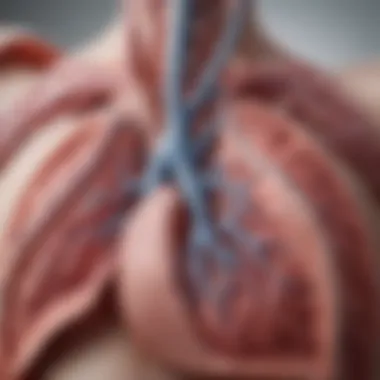Understanding Left Lobe Lung Cancer: Insights and Impact


Background and Context
Left lobe lung cancer represents a significant challenge in oncology. This cancer type emerges specifically within the left lobe of the lungs, which holds unique characteristics that differ from malignancies in other regions. The left lung contains two lobes, upper and lower, leaving it vulnerable to specific types of lung cancers, including adenocarcinoma and squamous cell carcinoma.
Historically, lung cancer has been a major public health concern, with research efforts spanning decades. The understanding of lung cancer's etiology, including its association with smoking and exposure to particular pollutants, has evolved. The left lobe's role in this narrative adds an additional layer of complexity, necessitating targeted research and clinical approaches.
"Understanding lung cancer requires not just observation, but a profound comprehension of the biological and behavioral factors that contribute to its development."
As we explore left lobe lung cancer, it is crucial to contextualize its epidemiology. Data indicates that while lung cancer is the leading cause of cancer death worldwide, region-specific factors can influence survival rates and treatment efficacy. This makes the study of left lobe lung cancer both important and relevant.
Key Findings and Discussion
Research into left lobe lung cancer has provided several notable findings. One significant result is the impact of early diagnosis on survival rates. Screening methods, such as low-dose computed tomography (CT) scans, have shown promise in detecting tumors at an earlier stage, which is critical for successful outcomes.
Major Results of Recent Studies
- Diagnosis: Advances in imaging technology have improved the ability to identify lung nodules, particularly in the left lobe. This has led to better diagnostic accuracy and earlier intervention.
- Treatment Options: There are a variety of treatment protocols available for patients diagnosed with left lobe lung cancer, including surgery, chemotherapy, and targeted therapies. The choice of treatment is often influenced by tumor size, patient health, and cancer stage.
- Prognostic Factors: Factors such as age, smoking history, and genetic markers play an essential role in determining patient prognosis. Recent studies indicate that personalized approaches to treatment can significantly enhance patient outcomes.
Detailed Analysis of Findings
Ongoing research continues to refine our understanding of left lobe lung cancer. The interplay between genetics and environmental factors is increasingly acknowledged. The lung cancer landscape is changing, with emerging therapies and diagnostic tools leading the way.
Continued education and awareness of this specific cancer type among healthcare professionals and the public are vital. Comprehensive knowledge can lead to better preventive measures and treatment modalities.
The evolution of treatment for lung cancer requires critical engagement from clinicians and researchers. Engaging with the latest research fosters a deeper insight into the challenges posed by left lobe lung cancer, and it is imperative to integrate these findings into clinical practice.
Foreword to Left Lobe Lung Cancer
Understanding left lobe lung cancer is crucial for several reasons. Being a specific area of lung cancer, it presents distinct challenges and treatment considerations. The left lung is divided into the left upper lobe and the left lower lobe, and cancer can manifest differently in each region. The implications of left lung cancer can be significant for patient outcomes, making this understanding paramount for healthcare providers and researchers alike.
This section lays a foundational understanding of what left lobe lung cancer entails, setting the stage for a deeper exploration of its etiology, pathophysiology, and treatment options.
Defining Lung Cancer
Lung cancer refers to the uncontrolled growth of abnormal cells in one or both lungs. It can occur in the air passages, affecting various parts of the lungs. Lung cancer is generally categorized into two main types: small cell lung cancer and non-small cell lung cancer. Small cell lung cancer is known for its aggressive nature and is closely linked to smoking. Conversely, non-small cell lung cancer is more common, accounting for approximately 85% of cases, and can be further classified into several subtypes.
A clear understanding of lung cancer is important because its classification directly influences treatment methods and prognostic outlooks.
Understanding the Left Lobe
The left lung comprises two lobes: the upper lobe and the lower lobe. These sections are elegantly designed to facilitate breathing and gas exchange, each serving a particular function. The left lobe, while slightly smaller than the right, plays a critical role in overall respiratory health.
Specific attention to the left lobe is significant because tumors can vary in behavior based on their location.
Common forms of tumors in the left lobe include adenocarcinoma, squamous cell carcinoma, and large cell carcinoma, each necessitating tailored therapeutic strategies. Awareness of the unique anatomical considerations of the left lobe is key for both diagnosis and treatment planning.
Acknowledgment of these aspects lays the groundwork for understanding the complexities of left lobe lung cancer and the specific challenges it presents.
Etiology and Risk Factors
Understanding the etiology and risk factors linked to left lobe lung cancer is essential for both prevention and treatment. By identifying the causes, health professionals can better equip patients with knowledge necessary to reduce their exposure to specific risks. This section breaks down the different aspects that contribute to the development of left lobe lung cancer, providing a comprehensive perspective on genetic, environmental, and lifestyle influences.
Genetic Predisposition
Genetic predisposition plays a pivotal role in the risk associated with left lobe lung cancer. Certain inherited mutations can increase one's susceptibility to various types of cancer, including lung cancer. For instance, mutations in genes such as TP53 and KRAS are seen frequently in lung cancer cases. Individuals with a family history of lung cancer may find themselves at a higher risk due to these genetic factors, suggesting that close monitoring and early detection strategies should be prioritized for them.
Notably, genetic testing and counseling can identify at-risk individuals. By understanding their genetic background, these individuals may take proactive steps in surveillance and lifestyle adjustments to mitigate risks.
Environmental Influences
Environmental influences contribute significantly to lung cancer etiology. Exposure to harmful substances is a critical risk factor. Notably, inhalation of tobacco smoke is the leading cause, accounting for approximately 85% of lung cancer cases. Additionally, exposure to secondhand smoke can increase risk, underscoring the importance of smoke-free environments.
Apart from tobacco, other substances such as radon, asbestos, and various industrial pollutants have been implicated in lung cancer development. For example, radon gas is a naturally occurring radioactive gas that can accumulate in homes, especially in poorly ventilated areas. Regular testing and mitigation strategies in residential areas can help reduce exposure.
Lifestyle Choices
Lifestyle choices significantly influence the risk of developing lung cancer. Smoking remains the most substantial modifiable risk factor. Although cessation can dramatically reduce the risk, it is important for individuals to recognize that even light or occasional smoking carries risks. Education on the dangers of smoking, alongside resources for quitting, is crucial in preventing lung cancer.
Diet also plays a role, as a diet rich in fruits and vegetables may provide some protective effects against lung cancer. Conversely, diets high in processed foods and low in nutrients could elevate risk levels. Engaging in regular physical activity and maintaining a healthy weight can also contribute positively to overall lung health.
In summary, understanding the etiology and risk factors associated with left lobe lung cancer is vital for prevention and early intervention. Genetic predisposition, environmental influences, and lifestyle choices amalgamate to create a framework for assessing risk. By addressing these elements, we can enhance awareness and better equip individuals to take charge of their lung health.
Pathophysiology of Left Lobe Lung Cancer
The pathophysiology of left lobe lung cancer is essential for understanding the mechanisms behind tumor development and progression. This knowledge aids in the identification of effective treatment strategies and patient management. It integrates the biological processes underpinning tumor behavior with the clinical implications. Understanding how tumors form in the left lobe can directly influence treatment approaches and prognosis, making it a critical part of the overall discussion of lung cancer.
Tumor Development


Tumor development in the left lobe involves a series of biological changes that begin at the cellular level. Cancerous cells arise when normal lung cells undergo mutations, disrupting their growth regulation. These mutations can be triggered by various factors, including genetic predisposition and environmental exposures. Once a mutation occurs, affected cells may proliferate uncontrollably, forming a mass or tumor. In the left lobe, this process may initially occur without noticeable symptoms, allowing tumors to grow significantly before detection.
The progression from a benign lesion to malignancy highlights the complex nature of cancer biology. The microenvironment within the lung, including the surrounding tissues, immune cells, and vascular components, plays a significant role in facilitating tumor growth. Tumors in the left lobe can exert pressure on adjacent structures, leading to complications such as pneumonia or pleural effusion. Understanding these dynamics is vital for diagnosing and treating left lobe lung cancer effectively.
Types of Tumors in the Left Lobe
The types of tumors in the left lobe can be classified into several categories, each with unique characteristics and implications for treatment. Broadly, lung tumors are categorized into two main types:
- Non-small cell lung cancer (NSCLC)
- Small cell lung cancer (SCLC) - This type is less common and tends to metastasize quickly, often presenting more advanced at diagnosis.
- Adenocarcinoma - Often associated with smoking and typically appears in outer lung areas, including the left lobe.
- Squamous cell carcinoma - More frequently linked to smoking, this type arises from the lining of the airways.
- Large cell carcinoma - Known for rapid growth and spread, affecting any part of the lung.
Additionally, tumors can exhibit varying histological features, which affect treatment strategies and prognostic outcomes. Research continues into specific variations within these tumor types, aiming to develop targeted therapies that mitigate adverse effects while improving survival rates.
"The types of tumors significantly influence treatment decisions and patient outcomes, underscoring the need for tailored approaches in managing lung cancer."
In summary, recognizing the nuances of tumor development and classification in the left lobe enhances the overall understanding of lung cancer. Accurate diagnosis and effective treatment depend on this foundational knowledge.
Clinical Presentation
Understanding the clinical presentation of left lobe lung cancer is essential for timely diagnosis and management. This section elucidates the typical manifestations of the disease, aiding healthcare professionals and laypersons alike in recognizing potential symptoms. Early detection is crucial for improving outcomes, and awareness of what to look for can lead to quicker interventions.
Common Symptoms
The symptoms of left lobe lung cancer can vary, depending on the stage of the disease and individual patient factors. Here are some of the most common signs:
- Persistent Cough: A new cough or a change in the character of a chronic cough can be an early indicator of lung cancer. It's important to monitor any unusual coughing patterns.
- Chest Pain: Pain in the chest may occur and can be mistaken for other conditions. This discomfort may worsen with deep breaths or coughing.
- Shortness of Breath: Patients may experience difficulty breathing or a sensation of breathlessness, which can develop over time.
- Weight Loss: Unintended weight loss without changes in diet or exercise can signal an underlying malignancy. This symptom should not be ignored.
- Fatigue: A notable increase in fatigue levels may be reported, impacting daily activities.
While these symptoms can arise from several different health issues, their presence in conjunction raises concern for lung cancer, particularly in individuals with risk factors.
Diagnosing Left Lobe Lung Cancer
Diagnosis begins with a thorough medical history and physical examination. Symptoms observed are first evaluated by healthcare professionals, often leading to further investigation through appropriate diagnostic tools. Key components in the diagnostic process include:
- Imaging Tests: Chest X-rays or CT scans are commonly used to visualize any abnormalities in the lungs. These scans can reveal masses or lesions that may indicate cancer.
- Biopsy: If imaging suggests the presence of cancer, a biopsy may be necessary to confirm the diagnosis. This involves obtaining a sample of suspicious tissue for pathological examination.
- Mediastinoscopy: This minimally invasive procedure allows for sampling lymph nodes to assess if cancer has spread beyond the initial site.
Effective diagnosis requires cooperation among medical professionals, including oncologists, radiologists, and pathologists. Proper assessment aids in determining the stage of the cancer and guides treatment options, contributing to better management of left lobe lung cancer.
"Early detection often signifies a higher chance for successful treatment. Recognizing clinical signs is a critical step in the fight against lung cancer."
Diagnostic Tools
In the realm of left lobe lung cancer, diagnostic tools serve as pivotal instruments in establishing an accurate diagnosis, guiding treatment decisions, and monitoring disease progression. Their importance cannot be overstated, as timely and precise diagnoses can significantly improve patient outcomes. Diagnostic tools encompass a variety of methodologies, including imaging techniques and biopsy procedures, each contributing crucial information about the nature and extent of the malignancy.
Imaging Techniques
Imaging techniques are the cornerstone of lung cancer diagnosis. They help visualize the lung structure and detect tumors or abnormalities. Common imaging modalities include:
- Chest X-rays: Often the first imaging test conducted, a chest X-ray can reveal lung masses or fluid accumulation. However, its ability to detect small tumors is limited.
- Computed Tomography (CT) scans: CT scans provide detailed cross-sectional images of the lungs. They are superior to X-rays in identifying smaller tumors and can assess the size and location of lesions.
- Positron Emission Tomography (PET) scans: PET scans enhance the understanding of metabolic activity in suspicious areas identified on CT scans. They can help determine whether a tumor is cancerous and whether it has spread to other organs.
- Magnetic Resonance Imaging (MRI): Although less common for lung cancer, MRI is useful for assessing tumors located near the mediastinum or spine.
Each of these techniques comes with its unique strengths and considerations. For instance, while CT scans are highly sensitive, they also expose patients to ionizing radiation. Understanding these factors is essential for healthcare professionals in balancing the benefits and risks of each imaging modality.
Biopsy Procedures
Biopsy procedures are critical for confirming the presence of cancer cells in lung tissue. They allow for histological examination and determination of tumor type, which is vital for tailoring treatment options. Common biopsy methods include:
- Needle Biopsy: This involves the use of a thin needle to extract tissue from the lung. CT-guided needle biopsies are generally reliable for targeting tumors directly.
- Bronchoscopy: This procedure uses a thin tube equipped with a camera to visualize the airways. A biopsy can be taken during this procedure if abnormalities are found.
- Surgical Biopsy: In instances where other methods are inconclusive, a surgical biopsy may be necessary. This can involve removing a part of the lung or the entire tumor.
The choice of biopsy method depends on several factors. These include the tumor’s size, location, and the overall health of the patient. The accuracy of biopsy results is contingent on the skill of the practitioner and the chosen technique.
"Getting a precise diagnosis is crucial. It ensures that every treatment approach is as effective as possible."
The integration of advanced imaging techniques and precise biopsy procedures has transformed the diagnostic landscape of left lobe lung cancer. As the field continues to evolve, staying updated on these tools and their applications remains vital for medical professionals.
Staging and Classification
Staging and classification of left lobe lung cancer are crucial as they help determine the extent of disease progression. Understanding these aspects aids in choosing appropriate treatment options, estimating prognosis, and facilitating communication among the healthcare team. This categorization is not just an academic exercise; it reflects real clinical decisions. A correct stage can significantly impact the treatment plan, helping doctors and patients navigate the complex landscape of cancer care.
The TNM System
The TNM system is the most widely used system for staging lung cancer. This system categorizes the cancer based on three primary factors:
- T (Tumor): Refers to the size and extent of the main tumor found in the lung. The size determines whether it has spread to nearby tissues.
- N (Nodes): Indicates whether the cancer has spread to lymph nodes in the surrounding areas.
- M (Metastasis): Describes whether the cancer has spread to other parts of the body.
By evaluating these factors, healthcare professionals can classify the cancer into stages ranging from 0 to IV. Each stage has distinct characteristics that influence treatment decisions and ongoing management.
"Accurate staging is critical for tailoring the most effective treatment regimen for each patient."


Stage-Dependent Treatment Approaches
Treatment options vary significantly depending on the stage at which left lobe lung cancer is diagnosed.
- Stage I: Usually involves surgical resection of the tumor, as it is localized. Patients often have better survival rates at this stage.
- Stage II: May still involve surgery, but adjuvant therapies like chemotherapy could be recommended to reduce the risk of recurrence.
- Stage III: Often necessitates a combination of surgery, chemotherapy, and radiation therapy. The goal is to manage more extensive disease.
- Stage IV: Represents advanced disease, often requiring systemic therapies such as chemotherapy, targeted therapy, or immunotherapy, as surgical options may no longer be viable.
Each stage presents its own challenges and opportunities in treatment, emphasizing the need for a tailored approach. Decisions should involve a multidisciplinary team, ensuring patients receive the most effective care aligned with their specific diagnoses.
Treatment Options
The treatment options for left lobe lung cancer play a crucial role in determining patient outcomes and overall survival rates. Each treatment modality may be considered based on various factors such as stage of cancer, patient’s health status, and personal therapy preferences. Understanding these options is vital for making informed decisions about care and managing this serious condition.
Surgical Interventions
Surgical interventions are often the first line of treatment for patients diagnosed with left lobe lung cancer, especially when the tumor is localized and has not spread. Surgery aims to remove the tumor and a margin of healthy tissue. This can potentially lead to the best outcomes in terms of survival. There are different types of surgeries:
- Lobectomy: Involves removing the left lobe of the lung.
- Wedge Resection: Removes a smaller, wedge-shaped portion of the lung.
- Pneumonectomy: Pertains to removal of an entire lung, which is less common.
Surgical candidates must undergo a thorough evaluation to ensure they can tolerate the procedure. Risks include infection, bleeding, and complications from anesthesia. Post-operative care and rehabilitation are also critical to assist patients in recovery, enhancing their lung function gradually.
Radiation Therapy
Radiation therapy is frequently employed in conjunction with surgery or as a sole treatment for patients who are not surgical candidates. This non-invasive option uses high-energy waves to destroy cancer cells. Two main types of radiation therapy are utilized:
- External Beam Radiation Therapy (EBRT): Delivers targeted radiation from outside the body.
- Brachytherapy: Involves placing radioactive material directly inside or near the tumor.
The advantages of radiation therapy include its ability to target tumors precisely, reducing damage to surrounding healthy tissue. Side effects can range from mild to severe; common issues include fatigue, skin irritation, and respiratory problems. Nonetheless, radiation can significantly improve results, especially for certain tumor types.
Chemotherapy Protocols
Chemotherapy protocols are highly relevant for advanced cases of left lobe lung cancer. This systemic treatment uses drugs to kill or slow the growth of cancer cells. Chemotherapy is often recommended when cancer is not confined to a single area, or when surgery is not feasible. Combination regimens may enhance effectiveness.
Commonly prescribed chemotherapy agents include cisplatin, carboplatin, and pemetrexed. However, chemotherapy can lead to numerous side effects, including:
- Nausea and vomiting
- Hair loss
- Immunosuppression
Careful management of these side effects is essential for maintaining quality of life during treatment.
Targeted Therapies
Targeted therapies represent a significant advancement in the treatment landscape for left lobe lung cancer. These therapies focus on specific genetic or molecular markers present in cancer cells, leading to more tailored and effective treatments. **Examples of targeted therapies include:
- Erlotinib (Tarceva)
- Afatinib (Gilotrif)**
Such therapies can be less toxic than traditional chemotherapy, as they specifically target cancer cells while sparing normal cells. The identification of suitable candidates often requires genetic testing of the tumor.
Immunotherapy Developments
Immunotherapy has emerged as a breakthrough in cancer treatment. It empowers the body’s immune system to recognize and fight cancer cells. Medications, such as nivolumab and pembrolizumab, are examples of immune checkpoint inhibitors currently showing promise.
Immunotherapy may be particularly beneficial for patients with specific biomarkers, such as those with high levels of programmed death-ligand 1 (PD-L1). Clinical trials continue to explore the efficacy and safety of these treatments, establishing their place in the treatment hierarchy.
Understanding and selecting the right treatment is imperative for maximizing patient outcomes. Engaging with healthcare professionals to tailor a treatment plan is essential.
The integration of multiple treatment options often produces the best results for left lobe lung cancer patients. A multidisciplinary approach involving surgeons, oncologists, and supportive care teams enhances both clinical outcomes and patient experience.
Complications and Prognosis
Complications and prognosis are vital components in the discussion of left lobe lung cancer. Understanding these elements is crucial for patients and healthcare professionals alike. This knowledge can significantly influence treatment decisions, survivor outcomes, and overall patient quality of life. Awareness of potential complications allows for better management and anticipation of patient needs. It also helps in formulating realistic expectations about treatment responses and disease progression.
Potential Complications
Left lobe lung cancer can lead to several complications that may impact the patient's health and daily life. These include:
- Respiratory Issues: Tumors in the left lobe may obstruct airways, leading to difficulty breathing, chronic cough, or infections such as pneumonia.
- Metastasis: The cancer can spread to other organs, including the liver, bones, or brain, complicating treatment plans and influencing prognosis negatively.
- Pleural Effusion: Accumulation of fluid in the pleural space can cause discomfort and respiratory distress, necessitating further medical intervention.
- Radiation Side Effects: Patients undergoing radiation therapy may experience skin irritation, fatigue, or esophagitis due to the proximity of the left lung to other vital structures.
- Surgical Risks: Surgical interventions carry inherent risks, such as infection, bleeding, or complications from anesthesia.
Understanding these potential complications allows healthcare teams to be proactive, creating tailored management plans to mitigate risks and address patient concerns effectively.
Survival Rates and Prognostic Factors
Survival rates for left lobe lung cancer vary based on several prognostic factors. Key factors influencing survival rates include:
- Stage at Diagnosis: Early detection of lung cancer typically correlates with better survival outcomes. The stage determines the extent of the disease and its treatability.
- Tumor Size and Type: Different tumor types, such as small cell or non-small cell lung cancer, have distinct prognoses. The characteristics of the tumor can also affect treatment efficacy.
- Patient’s Overall Health: Comorbidities and general health status significantly impact the individual's ability to tolerate aggressive treatments.
- Genetic Factors: Genetic variations may influence how a patient responds to treatment, affecting overall outcomes.
- Response to Treatment: How well a patient responds to initial treatment can serve as a critical indicator for future management strategies and likely outcomes.
It is imperative for both patients and healthcare providers to understand these factors, as they play a significant role in shaping treatment plans and setting realistic expectations for recovery.
In summary, understanding complications and prognostic factors in left lobe lung cancer is essential for improving patient care and outcomes. Ongoing research seeks to uncover more nuanced knowledge that could inform better practices and innovations in treatment.


Psychosocial Aspects
Psychosocial aspects play a critical role in the management of left lobe lung cancer. The emotional and psychological dimensions connected to this disease can significantly influence patient outcomes. Understanding these aspects helps healthcare providers support patients better. Addressing the psychosocial needs can alleviate distress and improve the quality of life.
Patients often face anxiety, depression, and uncertainty regarding their diagnosis and treatment. The intersection of physical health and psychological well-being is crucial. For instance, a patient who feels supported emotionally may have a better response to treatment. Additionally, strong social connections can positively affect coping strategies.
The recognition of psychosocial elements in cancer care leads to improved patient experiences. Effective communication between healthcare providers and patients enhances trust, facilitating a better understanding of treatment plans and potential outcomes.
Impact on Quality of Life
The impact of left lobe lung cancer on quality of life is profound. Patients might experience changes in physical abilities due to the illness. Symptoms such as chronic cough, fatigue, and pain can limit daily activities and social interactions. Moreover, the fear of progression can create psychological barriers.
Studies show that patients with lung cancer who engage in supportive care exhibit fewer debilitating symptoms. Managing pain and discomfort is vital not only for survival but also for enjoying life. Support groups can provide valuable insight into coping mechanisms.
"The journey through lung cancer is not solely medical; it encompasses the emotional and psychological landscape."
Maintaining a positive outlook can significantly enhance life satisfaction. Activities that promote relaxation and emotional balance contribute to improved mental health. For instance, mindfulness practices and counseling can serve as effective tools for management.
Support Systems and Resources
Support systems are fundamental for individuals facing left lobe lung cancer. These systems can be formal or informal, including family, friends, and professional caregivers. Having a reliable support network can make a considerable difference in coping with the stressors of cancer.
Some useful resources include:
- Cancer support groups, which provide shared experiences and emotional support
- Online forums such as Reddit, where discussions about symptoms and treatment experiences occur
- Websites like Wikipedia, offering detailed information on lung cancer
- Local community services that can assist with logistical challenges, like transportation to medical appointments
Education for both patients and families is crucial. Providing information about the disease and treatment options can empower patients. Furthermore, access to mental health professionals is essential for managing emotional burdens.
Emerging Research and Innovations
The field of oncology continuously evolves, driven by advancements in technology and a deeper understanding of cancer biology. Emerging research and innovations are critical to improving outcomes for patients with left lobe lung cancer. This section discusses how these developments influence treatment strategies, enhance patient care, and provide new insights into the disease's pathology.
Personalized Medicine Approaches
Personalized medicine is a paradigm shift in cancer treatment. It tailors therapies based on individual patient characteristics, including genetic makeup and tumor biology. For left lobe lung cancer, this approach means that treatments are not only based on broad categories like cancer stage or type but also consider unique molecular factors.
Some significant benefits of personalized medicine include:
- Targeted Therapies: Drugs designed to target specific mutations or pathways in cancer cells can improve efficacy and minimize side effects compared to conventional therapies.
- Genomic Profiling: Techniques such as next-generation sequencing allow for a comprehensive analysis of a patient's tumor, identifying actionable mutations that guide therapy decisions.
- Enhanced Patient Engagement: Patients become more involved in their treatment plans when they understand the specific characteristics of their cancer, enabling informed decisions.
Despite its benefits, the implementation of personalized medicine faces challenges, such as the availability of testing and the need for more clinical trials to assess the effectiveness of tailored therapies for left lobe lung cancer.
Clinical Trials and New Discoveries
Clinical trials remain at the forefront of developing innovative treatments for left lobe lung cancer. They play a crucial role in testing new drugs, combinations of therapies, and novel delivery methods. Participation in clinical trials provides patients access to cutting-edge treatments that may not yet be available through standard care.
Some key aspects of current clinical trials include:
- Exploration of New Drug Combinations: Researchers are investigating how combining existing treatments with newer agents may enhance therapeutic outcomes.
- Investigation of Novel Agents: New drugs and immunotherapies are constantly under evaluation to determine their safety, effectiveness, and optimal usage in real-world settings.
- Longitudinal Studies: These trials help understand long-term outcomes and the effects of treatments on quality of life.
Effective communication about trial availability and criteria is essential. As more discoveries emerge, the scientific community is charged with disseminating findings to maximize patient access to these new opportunities.
"Clinical trials are essential for bringing the latest cancer treatments from the laboratory to the patient."
The Ends and Future Directions
Understanding left lobe lung cancer is crucial, as it forms a significant aspect of pulmonary malignancies. This section encapsulates the key insights gained throughout the article, emphasizing the implications for patient care and future research. The progression of knowledge surrounding this cancer type has a direct effect on survival rates and treatment methodologies, providing a channel for developing targeted interventions.
When assessing the complexity of this cancer, several factors emerge as particularly salient. These include the importance of early detection, advancements in imaging technologies, and the emergence of tailored therapies. Each factor holds the potential to not only improve patient outcomes but also to elevate the standard of care delivered by healthcare professionals.
In addition, the significance of incorporating emerging research and new findings cannot be overstated. As this field evolves, continuous engagement with the most recent data will be vital for optimizing treatment protocols and enhancing therapeutic efficacy. Hence, ongoing education and training are essential for practitioners to remain at the forefront of patient care.
"Continuing research efforts are vital for uncovering innovative treatment strategies and understanding the complexities of left lobe lung cancer."
Summary of Key Takeaways
- Early Diagnosis: Identifying left lobe lung cancer at an early stage significantly improves treatment success and patient survival rates.
- Technological Innovations: Developments in imaging technologies have revolutionized diagnostic accuracy, allowing for more effective monitoring of tumor progression.
- Multifaceted Treatment Approaches: A combination of surgery, chemotherapy, radiation, and targeted therapies presents the best strategy for managing this cancer.
- Holistic Patient Care: Addressing psychosocial impacts is as important as treating the cancer itself, thus enhancing overall quality of life for patients.
The Need for Continued Research
The landscape of cancer research is ever-changing, making continued exploration essential. Research into left lobe lung cancer is not only about treatment improvements but also about understanding its molecular pathology better. Investigating the genetic markers linked to this cancer allows for personalized medicine approaches, targeting therapies based on individual patient profiles.
Moreover, clinical trials play a crucial role in validating new treatment methods. Engaging patients in these studies contributes to the advancement of knowledge and can offer access to cutting-edge therapies.
In summary, the commitment to ongoing study, clinical trials, and multi-disciplinary collaboration will pave the way for a brighter future in managing left lobe lung cancer, fostering hope for patients and healthcare providers alike.
Citing Relevant Literature
Citing relevant literature is a practice that underpins all forms of academic writing. In the context of left lobe lung cancer, it highlights findings from peer-reviewed studies, clinical trials, and established medical texts. Here are some reasons why this practice is essential:
- Validation of Claims: Each statement regarding the symptoms, treatment options, or outcomes can be backed by research, ensuring the information is accurate and trustworthy.
- Roadmap for Further Study: References enable readers to explore topics in depth. They can follow the cited study or article to gain a broader perspective.
- Interdisciplinary Connections: The disease does not exist in a vacuum. References allow for connections to be made between different fields of study like genetics, oncology, and environmental science.
- Credibility: For educators and professionals, citing established works enhances the authority of their teachings and practices in clinical settings.
- Acknowledgment of Sources: Citing literature also shows respect for the original researchers' contributions, fostering an environment of collaboration and mutual advancement.
Providing a strong reference section will ensure that the insights gathered throughout this article are well-founded. Researchers and professionals looking to understand left lobe lung cancer will find this compilation of sources invaluable.







